Biography of Roger Gale 1673-1744
Roger Gale 1673-1744 is in Antiquaries.
On 01 Jan 1673 [his father] Thomas Gale (age 38) and [his mother] Barbara Pepys were married.
After 01 Jan 1673 Roger Gale was born to Thomas Gale (age 38) and Barbara Pepys at Impington. Some sources describe his birth on 27 Sep 1672 however this is inconsistent with his parents marriage on 01 Jan 1673.
Before 1689 [his step-father] Thomas Gale Scholar (age 54) and [his mother] Barbara Pepys were married.
In 1689 [his mother] Barbara Pepys died.
On 08 Apr 1702 [his father] Thomas Gale (age 67) died.
On 03 Dec 1705 Roger Gale (age 32) was elected MP Northallerton in a by-election which seat he held until 1713 when his he didn't stand.
Itinerarium Antonini Augusti aka Antonine Itinerary by [his father] Thomas Gale was published posthumously, with notes by his son Roger Gale (age 35).
In 1709 Roger Gale (age 35) published his father's work on the Antonine Itinerary, which Gale supplemented with his own notes and commentary.
On 28 Mar 1717 Roger Gale (age 44) was elected Fellow of the Royal Society.
Minutes of the Society of Antiquaries. 10 Dec 1718. Mr Norroy (age 57) brought us an old deed of Isabella de Fortibus with a Seal, where her Arms are impaled with those of her husband very remarkably thus.
And Roger Gale (age 45) Esq brought an Inscription to be put upon the plate of Richard II with a very judicious disertation upon the date and painting of the same being in oil colours, for which he had the thanks of the Society.
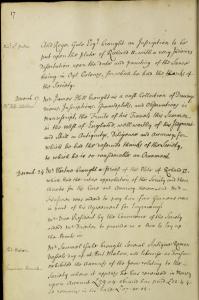
Minutes of the Society of Antiquaries. 11 Mar 1719. It was proposed that [?] noblemen and persons of quality as please to be members of the Society may be admitted by Ballot.
Ordered the same day a dividend of one print more of Ulphus's Horn to every member.
Resolved that Mr Vertue (age 35) goe to Kensington Pallace to view the pictures of Holbein, copied there by Remy, the originals being burned in Whitehall.
Resolved that in [his brother] Mr Samuel Gale's (age 36) dissertation upon Ulphus's Horn be revised by Mr President (age 58), Mr Roger Gale (age 46), Mr Mickleton and Mr Holmes (age 57), or any three of them, and then printed.
NB. Ten members were present when the last resolution was made.
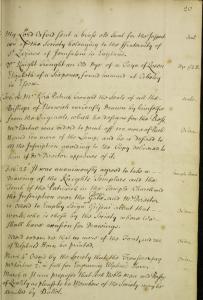
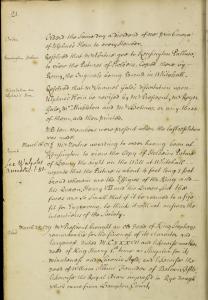
Minutes of the Society of Antiquaries. 25 Mar 1719. Mr President brought an old deed of King Stephen's remarkable for the finesse of its character and largeness, dated MCXXXVII [1137] and likewise another deed of King Harry Ist's time as singlular for its minuteness and laconic style, and likewise the deed of William Albini founder of Belvoir Castle [Map], likewise the Royal Arms impressed in Rye dough which came from Hampton Court [Map].

Mr Director brought a sketch of a design of a plate to be printed as a headpiece or Emblem of the Works of the Society at the beginning of any publications, which he was ordered to to have [?]. Mr President made a Report in the name of those gentlemen who were ordered to revise Mr Samuel Gale's dissertation upon Ulphus's Horn and what alterations they hinted at, are submitted to the Author pleasure, and the work is ordered to be published and printed in a good manner in Quarto by Mr Gossin [?] at the charges of the Society with a print of the Horn before it, whereof a sufficient number are likewise ordered to be printed off. It was ordered by the Society that a manuscript of the Cotton Library being [?] Registrum Honors de Richmond with the Illuminations therein, be printed at their charges, and Mr Roger Gale (age 46) is disposed to get it transcribed, in order thereto, and the Director to have the drawings therein copied to be engraven, the whole to be done in the same form and magnitude with the original.

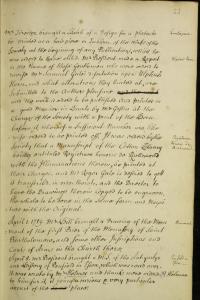
Avebury by William Stukeley. At the bottom of these pastures on the right, runs the virgin stream of Kennet, just parted from its fountain by Silbury-hill [Map]. One stone is still standing by a little green lane going down to the river. Now our avenue marches directly up the hill, across some ploughed fields, still by the hedge of the Marlborough road, where yet stands another stone belonging to it. Then we are brought to the very summit of the celebrated Overton-hill, properly the Hakpen or head of the snake, which is 7000 feet from the vallum of Abury town. 400 cubits, according to Herodotus II, was the stadium of the ancients, our furlong; a space that Hercules is said to run over at one breath. Had the side-interval of the stones of this avenue been the same throughout, 50 cubits, that repeated 100 times the number of the intervals, would produce 5000 cubits. But because, as I said, they lessened this interval proportionably, as they came to the neck of the snake, it amounts to 4000 cubits, which is ten stadia, an eastern mile in Dr. Arbuthnot's tables, amounting to 7000 feet, as Mr. Roger Gale (age 50) and I measured its whole length.
Avebury by William Stukeley. The learned Dr. Bogan in his letter prefixed to Delphi phœniciss. from Æschylus and others, Ικετ. ά. shews, that men were often called snakes by the ancients, in an allegorical way; and as to the report of Cadmus and his wife, of the Sidonian women and others, turned into snakes, or stones, or birds, or trees, in the sense we are explaining them; 'tis no more than what we daily see and hear at this time, in these very Druid temples of our own island, which we are speaking of. The people who live at Chippin-Norton and all the country round our first described temple of Rowldrich; affirm most constantly and as surely believe it, that the stones composing this work are a king, his nobles and commons turned into stones. They quote an ancient proverb for it, concerning that tall stone, called the king stone.
If Long-Compton thou canst see,
Then king of England shall thou be.
And as Mr. Roger Gale (age 50) wrote once to me from the place: "tis the creed of all that country, and whoever dares to contradict it, is looked upon as the most audacious free-thinker."
Avebury by William Stukeley. Abury is not the only temple in Britain formed on this design of the circle and serpent. I saw another at Shap in Westmorland, when I travelled thro' the place, anno 1725, with Mr. Roger Gale (age 50). But I had no opportunity of examining into it.
Avebury by William Stukeley. The whole of this temple, wherein the town of Abury is included I have laid down in Table I, the frontispiece, done from innumerable mensurations, by which means I fully learned the scheme and purport of the founders. 'Tis comprehended within a circular ditch or trench above 1400 foot in diameter, which makes 800 cubits, being two stadia of the ancients. A radius of 400 cubits, one stadium, struck the inner periphery of the ditch, in the turf. This is done with a sufficient, tho' not a mathematical exact20ness. They were not careful in this great measure, where preciseness would have no effect, seeing the whole circle cannot be taken in by the eye on the same level. The ditch is near 80 foot, which is 45 cubits broad, very deep, like the foss that encompasses an old castle. The great quantity of solid chalk dug out of it, is thrown on the outside, where it forms a mighty vallum, an amphitheatrical terrace, which hides the sight of the town as we come near it, and affords a good shelter from the winds. 'Tis of the same breadth at bottom as the ditch at top. The compass of this, on the outside, Mr. Roger Gale (age 50) and I measured about 4800 feet, August 16, 1721.
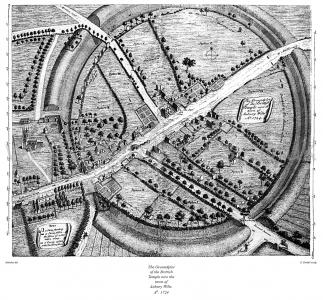
Avebury by William Stukeley. In the year 1725, I travelled over the western and northern parts of England, in company of Mr. Roger Gale (age 51), a gentleman well known to the learned world; as his father. Dr. Thomas Gale, dean of York. I was requested, by some lovers of antiquity, to transcribe those notes which I wrote day by day during our journey; and though I had visited several of the places, through which we passed, in my former journeys, yet a second view (especially in company of a person so well versed in antiquities) gave me an opportunity of making some farther remarks, which I flatter myself may be of use to those who are fond of studying the antiquities of our own country.
On 25 Jun 1744 Roger Gale (age 71) died. He was buried at St Radegund's Church, Scruton with the stipulation that he be buried in such a manner that no one would know exactly where he was buried.
Father: Thomas Gale
Great x 4 Grandfather: William Pepys of Cottenham
Great x 3 Grandfather: William Pepys of Cottenham
Great x 2 Grandfather: John Pepys of Impington
Great x 1 Grandfather: Talbot Pepys
GrandFather: Roger Pepys
Mother: Barbara Pepys